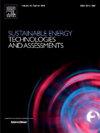共享微型交通的碳减排潜力比较分析
IF 7.1
2区 工程技术
Q1 ENERGY & FUELS
Sustainable Energy Technologies and Assessments
Pub Date : 2024-11-20
DOI:10.1016/j.seta.2024.104088
引用次数: 0
摘要
共享微型交通系统(SMS)近来发展迅速,为减少能源消耗提供了新的绿色交通选择。为了更好地了解共享单车对环境的影响,本文利用海量用户生成的出行数据,比较研究了中国三个处于不同经济发展阶段的城市(滨江、武城和象山)的无桩共享单车和电动自行车的碳减排潜力。结果显示,这三个城市的共享单车和电动自行车在一周内分别减少了 41.51 吨和 31.84 吨二氧化碳排放。共享电动自行车的出行环境效益为 155.11 克二氧化碳,高于共享单车(132.03 克)。减少的碳排放大部分来自于替代驾车出行,但共享电动自行车甚至通过替代公共交通和步行产生了额外的碳排放。碳减排模式呈现时空异质性。从空间上看,减少的碳排放量主要集中在吴城/象山的中心区域,而在经济活力较强的滨江,碳排放量分布较为分散。从时间上看,短信的碳减排模式与典型的时间使用模式相似。在所有城市中,餐饮和购物对 SMS 的碳减排贡献最大。在滨江,换乘和工作出行减少了更多的碳排放,而在武城,以回家和上学为目的的共享单车出行减少了相对更多的碳排放。我们的分析有助于我们更好地了解短信服务在不同城市背景下对环境的影响,并为相关交通规划提供信息,以实现城市的碳中和。本文章由计算机程序翻译,如有差异,请以英文原文为准。
A comparative analysis of the potential of carbon emission reductions from shared micro-mobility
Shared micro-mobility systems (SMSs) have recently experienced rapid growth, providing new green mobility options to reduce energy use. To better understand SMS’s environmental impact, this paper comparatively examines the potential of carbon emission reductions from dockless shared bikes and e-bikes in three Chinese cities at different economic development stages (i.e., Binjiang, Wucheng and Xiangshan) using massive user-generated trips. Results show that shared bikes and e-bikes in the three cities reduced 41.51 and 31.84 tonnes of CO2 emissions over a week, respectively. The trip-level environmental benefit of shared e-bikes is 155.11 g of CO2, higher than that of shared bikes (132.03 g). Most of the reduced carbon emissions are from substituting driving trips, but shared e-bikes even generate extra carbon emissions by substituting public transit and walking. Patterns of carbon emission reductions show spatiotemporal heterogeneity. Spatially, reduced carbon emissions are concentrated in central areas of Wucheng/Xiangshan and more dispersedly distributed in Binjiang, which is a more economically vibrant city. From a temporal perspective, SMS’s carbon reduction patterns are similar to typical temporal usage patterns. The Dining and Shopping trips contribute the most to SMS’s carbon reductions in all cities. Binjiang has more carbon emissions reduced from the Transfer and Working trips, and shared bike trips with the Home and Schooling purposes reduced relatively more carbon emissions in Wucheng. Our analysis helps us better understand the environmental impact of SMSs across various urban contexts and inform relevant transport planning to achieve carbon neutrality in cities.
求助全文
通过发布文献求助,成功后即可免费获取论文全文。
去求助
来源期刊

Sustainable Energy Technologies and Assessments
Energy-Renewable Energy, Sustainability and the Environment
CiteScore
12.70
自引率
12.50%
发文量
1091
期刊介绍:
Encouraging a transition to a sustainable energy future is imperative for our world. Technologies that enable this shift in various sectors like transportation, heating, and power systems are of utmost importance. Sustainable Energy Technologies and Assessments welcomes papers focusing on a range of aspects and levels of technological advancements in energy generation and utilization. The aim is to reduce the negative environmental impact associated with energy production and consumption, spanning from laboratory experiments to real-world applications in the commercial sector.
 求助内容:
求助内容: 应助结果提醒方式:
应助结果提醒方式:


